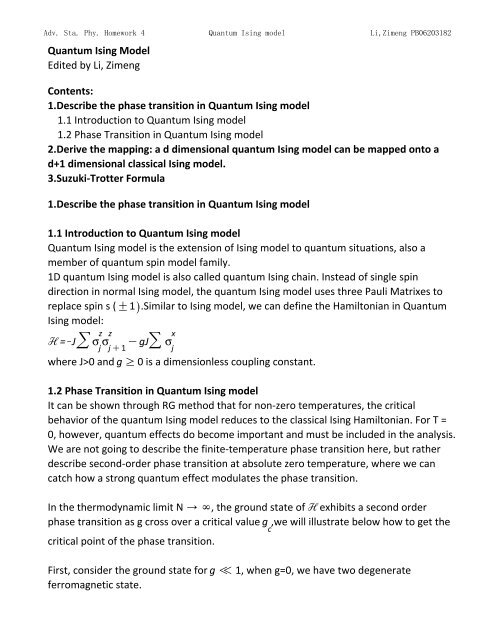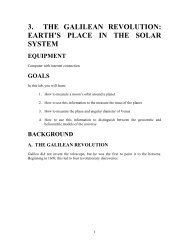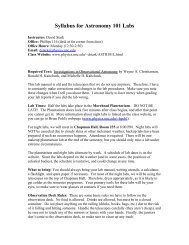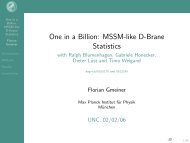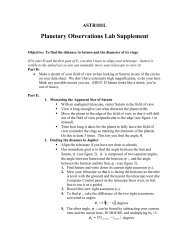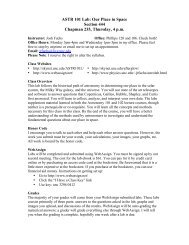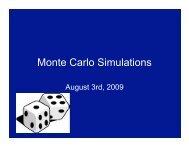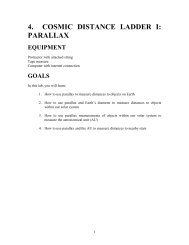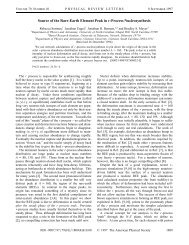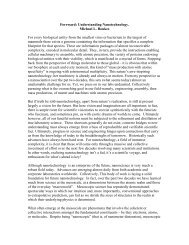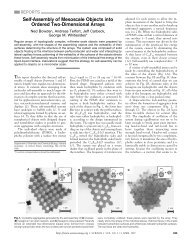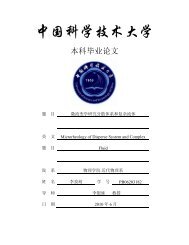Topics in Statistic Mechanics
Topics in Statistic Mechanics
Topics in Statistic Mechanics
Create successful ePaper yourself
Turn your PDF publications into a flip-book with our unique Google optimized e-Paper software.
Adv. Sta. Phy. Homework 4 Quantum Is<strong>in</strong>g model Li,Zimeng PB06203182<br />
Quantum Is<strong>in</strong>g Model<br />
Edited by Li, Zimeng<br />
Contents:<br />
1.Describe the phase transition <strong>in</strong> Quantum Is<strong>in</strong>g model<br />
1.1 Introduction to Quantum Is<strong>in</strong>g model<br />
1.2 Phase Transition <strong>in</strong> Quantum Is<strong>in</strong>g model<br />
2.Derive the mapp<strong>in</strong>g: a d dimensional quantum Is<strong>in</strong>g model can be mapped onto a<br />
d+1 dimensional classical Is<strong>in</strong>g model.<br />
3.Suzuki-Trotter Formula<br />
1.Describe the phase transition <strong>in</strong> Quantum Is<strong>in</strong>g model<br />
1.1 Introduction to Quantum Is<strong>in</strong>g model<br />
Quantum Is<strong>in</strong>g model is the extension of Is<strong>in</strong>g model to quantum situations, also a<br />
member of quantum sp<strong>in</strong> model family.<br />
1D quantum Is<strong>in</strong>g model is also called quantum Is<strong>in</strong>g cha<strong>in</strong>. Instead of s<strong>in</strong>gle sp<strong>in</strong><br />
direction <strong>in</strong> normal Is<strong>in</strong>g model, the quantum Is<strong>in</strong>g model uses three Pauli Matrixes to<br />
replace sp<strong>in</strong> s ( .Similar to Is<strong>in</strong>g model, we can def<strong>in</strong>e the Hamiltonian <strong>in</strong> Quantum<br />
Is<strong>in</strong>g model:<br />
where J>0 and<br />
is a dimensionless coupl<strong>in</strong>g constant.<br />
1.2 Phase Transition <strong>in</strong> Quantum Is<strong>in</strong>g model<br />
It can be shown through RG method that for non-zero temperatures, the critical<br />
behavior of the quantum Is<strong>in</strong>g model reduces to the classical Is<strong>in</strong>g Hamiltonian. For T =<br />
0, however, quantum effects do become important and must be <strong>in</strong>cluded <strong>in</strong> the analysis.<br />
We are not go<strong>in</strong>g to describe the f<strong>in</strong>ite-temperature phase transition here, but rather<br />
describe second-order phase transition at absolute zero temperature, where we can<br />
catch how a strong quantum effect modulates the phase transition.<br />
In the thermodynamic limit N , the ground state of exhibits a second order<br />
phase transition as g cross over a critical value ,we will illustrate below how to get the<br />
critical po<strong>in</strong>t of the phase transition.<br />
First, consider the ground state for<br />
ferromagnetic state.<br />
, when g=0, we have two degenerate


